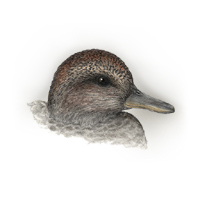|
Field
Guide IDs: BREEDING:
Freshwater (and
rarely brackish) marshes, brushy, grassy areas away
from water; on lake islands. 1 brood. DISPLAYS:
In courtship, male
raises black posterior out of water and shows
speculum while bobbing head. See: Duck_Displays. NEST:
Usu concealed in
dense grass, tall reeds, or under brush; made of
nearby veg. Building continues during laying. Lined
with finer materials; down added during
incubation. EGGS:
White. 2.2" (55
mm). DIET:
Grass, aquatic
plants, nuts, grain; aquatic invertebrates, small
vertebrates. Dives for food more than most
dabblers. In winter, mostly aquatic veg,
algae. CONSERVATION:
Winters s to s
Mexico. Range expanding e. NOTES:
Nesting success
often higher than other dabblers. Strong female
nest site tenacity. Nest parasitism by other
Gadwalls and by scaup, not uncommon. Breeding
season later than most other ducks. Gadwalls feed
farther from shore than do other
dabblers. Uncommon to fairly
common winter visitor at Lagunita, usually seen
foraging in shallows at the edge of the lake. Birds
lingering into spring may occasionally nest here,
although breeding has not yet been
recorded. ESSAYS: Dabblers
vs. Divers;
Piracy;
Parasitized
Ducks;
Site
Tenacity. REFERENCES:
Bellrose, 1976;
Gooders and Boyer, 1986; Hepp, 1985; Hines and
Mitchell, 1983, 1984. |
